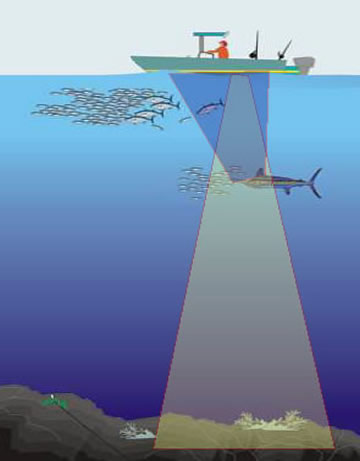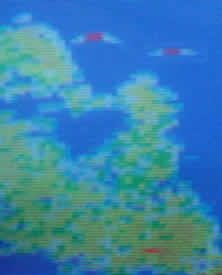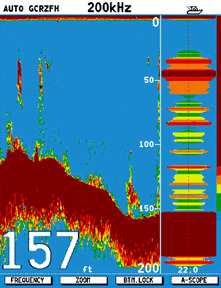2. Depth Sounders
Between The Lines - Ch 11: Finding Fish
Used correctly a depth sounder or fish finder can be a valuable tool in identifying likely fishing areas. Used incorrectly they are of little use. In fact, the way they are most often used they can spook bait and fish. Once we analyse how a sounder works, and the way it displays information using them correctly, it will become apparent how it has less effect on the fish themselves.
Depth sounders work by sending a sound through a transducer. The sound is bounced back to the transducer by anything that lays in its path such as fish, air pockets, structure and of course the sea bottom. (Fig 1) The returned sound is then processed and displayed on the sounder screen with an indication of its depth, size and density via display shading or colour. Note the sound will bounce off fish on the way down. The beam does not have to hit the bottom.
 |
|
| Fig 2 | |
 |
|
| Fig 1 | Fig 3 |
The sounder screen is made up of pixels, that is, little blocks of colour. (Fig 2) Most modern sounders have a relatively high pixel count. Generally the larger the screen the more pixels you get and therefore the better the picture. However, the definition is still based on how much information you are trying to see at any one time. For example, if the depth is, say, 300-feet and you have a high-grade sounder of say 600 pixels deep, then you would have two pixels per foot. That said, there are often menus or data boxes at the top and the bottom contour which usually takes up at least 20 percent of the bottom of the screen so you have less than two pixels per foot. At a depth of 600-feet, you have less than one pixel per foot.
To reach the bottom at greater depths many sounders filter the surface readings, often down to 50 percent of the depth shown so they do not register or display anything near the top.
For the purpose of trolling lures we are most interested in the top layers, say from the surface down to 120-feet or 40-metres. If we zoom into that area we now have 5 to 6 pixels per foot which will offer a much greater definition, in fact, a definition that may be high enough to distinguish between baitfish and individual predators. (Fig 3)
Zooming into these tighter surface zones for better definition and delivering better quality information doesn't need the maximum power. In fact, the low power option set on the highest frequency will do a better job. This low power and higher frequency option are also less likely to spook the baitfish and predators, especially if making repetitive passes over the area. (Vid 1)
 |
|
| Vid 1 | Fig 4 |
 Often finding likely areas is made easier by noting the changes in water temperature readout on the sounder. The greater the temperature change over the shortest distance the more likely predators are with the bait schools. The temperature history graph can be a great help in retracing your track to the most likely area. Ideally, when trolling skirted lures on the surface you are looking for tight balled up bait within the top 200-feet (60 metres). Rather than a huge mass of bait that fills the screen a smaller ball that has broken away from the main school by predators is ideal. Note that much of the screen is filled with historical information, which is water you have already covered. The area of greatest interest is at the beginning of the scrolling image. Using the ‘A-scope' function will display a real-time image of the bottom structure and fish directly below the transducer. (Fig 4)
Often finding likely areas is made easier by noting the changes in water temperature readout on the sounder. The greater the temperature change over the shortest distance the more likely predators are with the bait schools. The temperature history graph can be a great help in retracing your track to the most likely area. Ideally, when trolling skirted lures on the surface you are looking for tight balled up bait within the top 200-feet (60 metres). Rather than a huge mass of bait that fills the screen a smaller ball that has broken away from the main school by predators is ideal. Note that much of the screen is filled with historical information, which is water you have already covered. The area of greatest interest is at the beginning of the scrolling image. Using the ‘A-scope' function will display a real-time image of the bottom structure and fish directly below the transducer. (Fig 4)
Despite the fact each electronic unit is expected to do it's duty in auto-mode, learning how to make simple adjustments to gain STC and depth shift allow you to get far more information easily and quickly which will aid in determining whether an area is likely to be productive.
Just as much emphasis has been made on the importance of training and preparation with the rest of the gear used, so learning how to use your electronics by going through the user manuals is certainly worthwhile and really quite easy. Even with several different units such as sounder, GPS, chart plotters with C-Map, radar and autopilot, all by Raymarine, being linked, the system is still very easy to use. It certainly makes you think: "Is it really fair to other boats competing against you, let alone the poor fish!"





